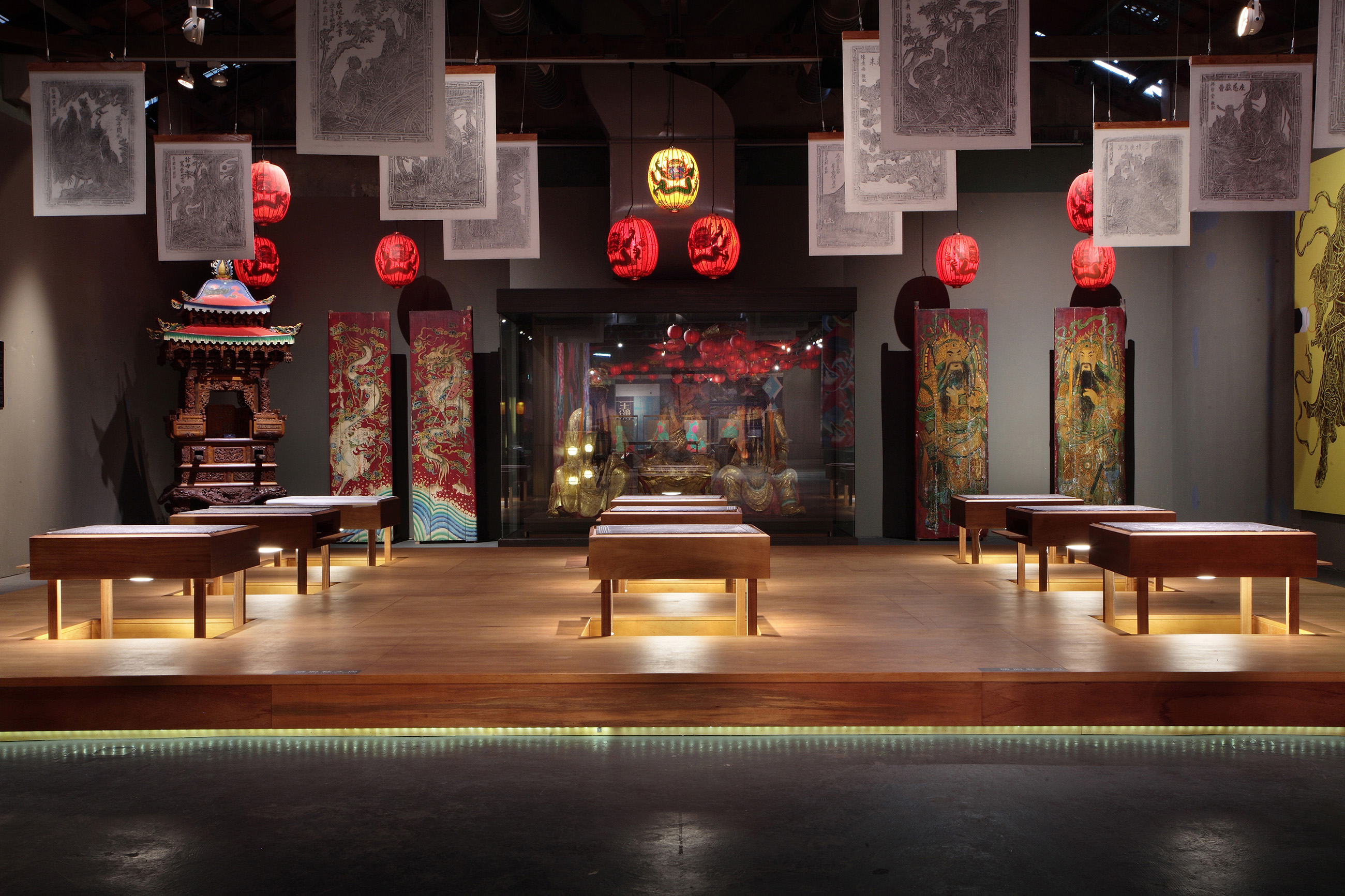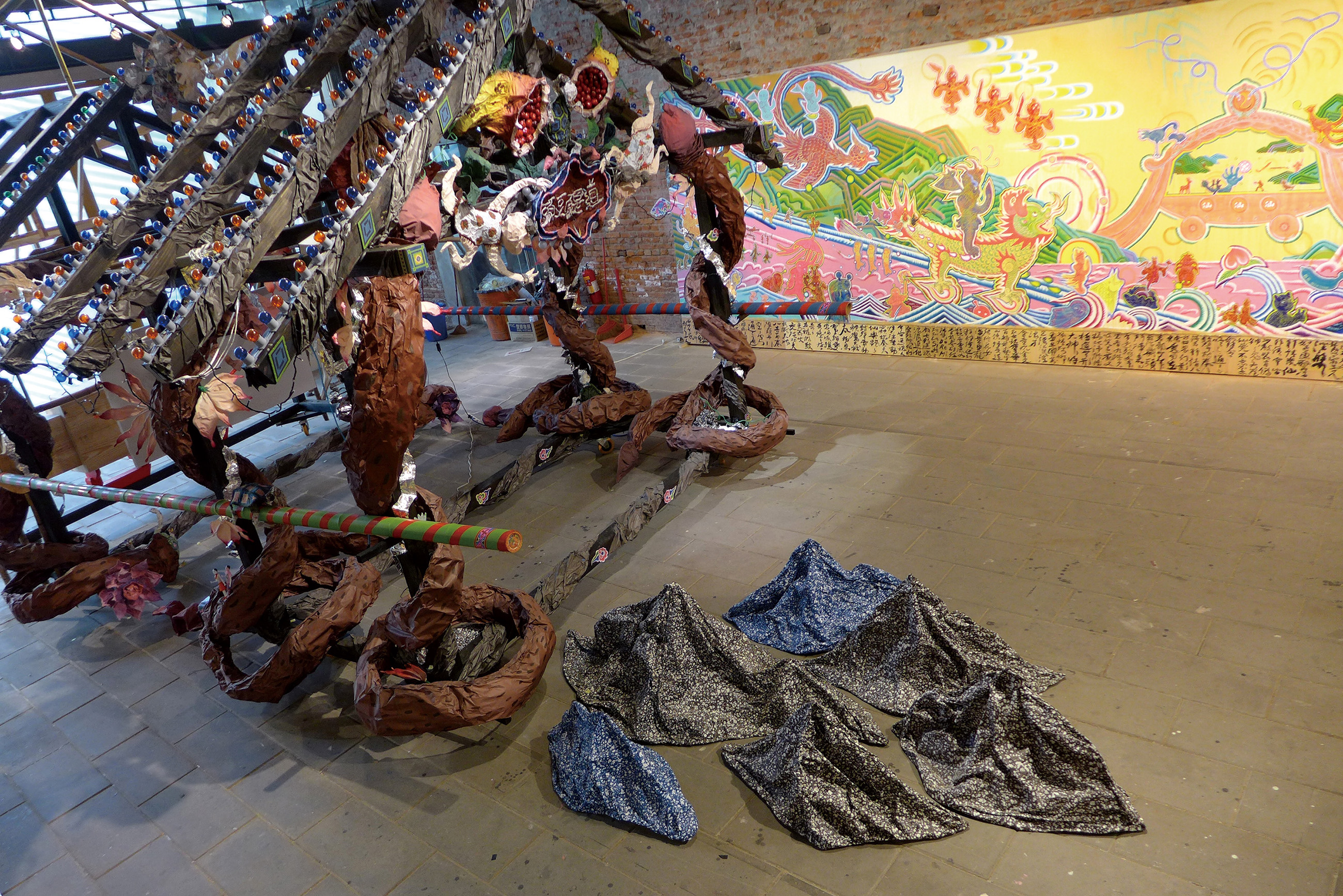當代藝術與民間信仰的文化祭可以碰撞出什麼樣的火花?「近未來的交陪:2017蕭壠國際當代藝術節」,從台南的「交陪境」傳統出發,著重於3個層次的當代交陪:創作中的技藝方法、儀式中的互動方法、政經結構中的自我組織方法,冀求突破僵化的現有藝術機制和廟宇文化生產體制,在當代藝術與民間藝術之間,打開一個新的藝術祭視野。
展覽首先呈現藝術祭的準備過程與方法,包括兩年多來的田調、編輯、論壇的呈現。2017年於文化園區全境開展廟壁大畫、巨幅門神、繪師畫稿、門神門板、廟牌木雕、攝影、設計、建築、物件、錄像、拼貼、檔案、繪畫、雕塑、紙藝、互動裝置、廊道影像等不同媒材與空間的作品,共有38組國內外藝術家於10個展間、4條廊道、10座城市浮洲建築參與展覽。
What sparks are generated in the collision between contemporary art and religious cultural folk festivals? With the Tainan tradition of the kau-puê companionship realm as a starting point, the 2017 Soulangh International Contemporary Art Festival, Kau-Puê, Mutual Companionship in Near Future emphasized three levels of contemporary kau-puê companionship: the skillful techniques in creativity, the interactive techniques in ritual ceremonies, and the self-organization techniques in the political structure – in hopes of transcending the rigidity in the production systems of existing arts institutions and temple culture, to open up a new horizon for arts festivals, located between contemporary art and folk art.
The exhibition began by presenting the arts festival preparatory processes and methods including presentations of field research, editorializing, and forums over the course of over two years. In 2017, exhibitions of grand temple murals, large-scale door gods, work drafts by master painters, door god door panels, carved wooden temple plaques, photography, design, architecture, objects, videos, collages, archives, paintings, sculptures, paper art, interactive installations, image corridors, and works of various media and spaces were presented throughout the cultural park. In total, over 38 teams of national and international artists participated in the exhibition across 10 gallery spaces, 4 corridors, and 10 urban floating island structures.
龔卓軍 GONG Jaw-Jiun
出生於台灣嘉義,任教於國立臺南藝術大學藝術創作理論研究所。曾以專書《身體部署:梅洛龐蒂與現象學之後》獲中央研究院年輕學者研究著作獎。近年從事當代藝術策展工作,包括2013年台北誠品畫廊的「我們是否工作過量?(Are We Working Too Much?)」展覽、2014年「絕對不純粹」東亞論壇:報民/AABB—台南/東京交流計畫、「鬼魂的迴返」台灣國際錄像藝術展等,2017年於蕭壠文化園區策畫「近未來的交陪:蕭壠國際當代藝術節」。
Born in Chiayi, Taiwan, GONG Jaw-Jiun was awarded the Academia Sinica's Junior Research Investigators Award for his book, Dispositif of Body: Merleau-Ponty at the Limits of Phenomenology. In recent years, he has been engaged in the work of curating contemporary art exhibitions, including the Eslite Gallery Exhibition Are We Working Too Much? in 2013; the Absolutely Impure exhibition for the East-Asia Forum: POST News/Art Against Black Box Tainan/Tokyo Exchange Project, as well as The Return of Ghosts for the 4th Taiwan International Video Art Exhibition in 2014; and the Kau-Puê, Mutual Companionship in Near Future exhibition for the 2017 Soulangh International Contemporary Art Festival.
陳伯義 CHEN Po-I
1972年生於臺灣嘉義,曾參加2014年國立臺灣美術館「臺灣美術家『刺客列傳』;1971~1980—六年級生」、2016年歐洲攝影之家「傾圮的明日」、2017年蕭壟文化園區「近未來的交陪:2017蕭壠國際當代藝術節」等展覽;2015年受推薦參加「r:ead # 4」東亞區域藝術交流平台。《紅毛港遷村實錄─家》獲得第13屆台新藝術獎年度得獎作品。
Born 1972 in Chiayi, CHEN Po-I has participated in "The Pioneers" of Taiwanese Artists,1971-1980 exhibition at the National Taiwan Museum of Fine Arts in 2014; the Lendemain chagrin exhibition at the Maison Européenne de la Photographie in 2016; and the Kau-Puê, Mutual Companionship in Near Future exhibition at the Soulangh International Contemporary Art Festival in 2017. He was recommended as a participant for the Residency East-Asia Dialogue (r:ead) #4 in 2015, and was recipient of the 13th Annual Taishin Arts Award for his work Home: Records of the Hongmaogang Village Relocation.
陳宣誠 Eric CHEN
國立臺南藝術大學藝術博士,現為中原大學建築系專任助理教授、共感地景創作|ArchiBlur Lab 主持建築師。長期探索在身體與地景間發展另一種重新定義建築的尺度,企圖用最真實的身體感,反覆地去體會事物最根本的價值,讓建築成為一種關於人的環境。主要的創作實踐為:《屋橋》(2015瀨戶內藝術祭家屋計劃)、《城市浮洲計畫》、馬來西亞《綠洲聚落計畫》,法國《懸山.浮橋》,《存在的邊界》(巴勒斯坦美術館典藏),以及《共感群體》(2016台北雙年展、2017夏伽雙年展)等。
Chung Yuan Christian University Department of Architecture associate professor Eric Chen received his doctorate in art from the National Tainan University of Arts, and is currently principal architect at ArchiBlur Lab. He has long explored the development of alternative scales between the body and the landscape to redefine architecture; time and again, attempting to experience the fundamental value of objects through realistic corporeality so that architecture becomes a human environment. Some key creative practices include: Kyoku (Bridge House) at the 2016 Setouchi Triennale Art House Project; Urban Floating Islands; Suspended Mountains, Floating Bridge in France; Threshold of Being (commissioned by The Palestinian Museum); and Collectivism, 2016 (Taipei Biennial 2016 and Sharjah Biennial 13).
陳盈瑛 CHEN Yen-Ing
1966年出生於屏東。曾任職於臺北市立美術館展覽組、《今藝術》主編、典藏藝術家庭叢書部暨《小典藏》總編輯。現為獨立自由工作者。
Born 1966 in Pingtung, CHEN Yen-Ing has served on the team at the Taipei Fine Arts Museum Exhibition Department, and as editor of Art & Collection (Artco) Monthly magazine, as well as editor-in-chief of the Art & Collection Group and Artco Kids magazine. She is currently an independent freelancer.
黃瓊瑩 HUANG Chiung-Ying
1967年生於高雄,國立中山大學公共事務管理研究所碩士畢業,通過國家高等考試二級文教行政類,曾參與衛武營藝術文化中心籌備、大東文化藝術中心籌備、長期策畫執行地方藝文扎根計畫,現任臺南市政府文化局文化園區管理科科長,經營蕭壠文化園區、總爺藝文中心及籌設水交社文化園區。
Born 1967 in Kaohsiung, HUANG Chiung-Ying received her master’s degree from the National Sun Yat-sen University Institute of Public Affairs Management, and has qualified under the National Higher Level Examination for Category Two Education and Cultural Administration. She was involved in establishing a Preparatory Office for the Wei Wu Ying Center for the Arts and for the Dadong Arts Center, and in planning executing projects to firmly establishing regional arts and culture. She currently serves as section chief of the Cultural Park Management Section at the Tainan City Government Cultural Affairs Bureau where she oversees the management of the Soulangh Cultural Park, the Tsung-Yeh Arts and Cultural Center, as well as preparatory planning for the Shuijiaoshe Cultural Park.
龔卓軍
陳伯義、陳宣誠、陳盈瑛、黃瓊瑩
沈昭良、林柏樑、姚瑞中、港千尋(日)、陳伯義、陳逸宏、Rich John Matheson(加)、劉振祥、李立中
何采柔、李俊陽、林書楷、張徐展、邱子晏、梁任宏、涂維政、賴志盛、Linda Toigo(義)、MihaŠtrukelj(斯洛維尼亞)、陳宣誠(城市浮洲)
林欣怡、高俊宏、張照堂、陳依純、陳冠彰、許家維、林燕農、張景泓
陳秋山、廖慶章、林正尉
小嫩豬(陳俊宇、倪祥、陳姿雅)、曾伯豪、蘇俊穎、班芝花劇團
胡一之、何佳興、羅文岑、松本直美(日)
共感地景創作|ArchiBlur Lab
臺南市蕭壠文化園區
關鍵字
藝術家談作品
「這項龐大的策展能夠完成,大家一路義氣相挺、相互交陪,功不可沒!」
當代藝術與民間信仰的文化祭可以碰撞出什麼樣的火花?
台南藝術大學藝術創作理論研究所所長龔卓軍,應臺南市政府文化局文化園區管理科科長黃瓊瑩之邀所規劃的《近未來的交陪》2017蕭壠國際當代藝術節,從台南的「交陪境」傳統出發,集結38組國內外藝術家,於文化園區10個展間、4條廊道、10座城市浮洲建築,展出廟壁大畫、巨幅門神、繪師畫稿、門神門板、廟牌木雕、攝影、設計、建築、物件、錄像、拼貼、檔案、繪畫、雕塑、紙藝、互動裝置、廊道影像等不同媒材與空間的作品,在當代藝術與民間信仰之間,打開一個新的藝術祭視野。
宮廟文化與當代藝術的交陪
黃瓊瑩表示,台南擁有全國最多的廟宇,由佳里糖廠轉型的蕭壠文化園區,周邊也擁有深厚的宮廟文化,而佳里金唐殿香科醮典的「蜈蚣陣」更是創下最長108節的金氏世界紀錄!然而台灣的民俗祭典與宮廟文化卻未在當代藝術佔有一席之地,因此,蕭壠文化園區趁著三年一度的香科醮典,希望透過當代藝術創作,以嶄新的角度呼應民間信仰的文化祭。
龔卓軍說,台語的「交陪」二字,其實是出自於台灣地方寺廟的「交陪境」結盟系統。地方廟宇無論是建醮、遶境、重修或神明聖誕,都會透過這個系統與鄰近的廟宇互動和交誼。此次策展則將「交陪」的意義擴大,從「民間在地信仰」、「近現代民間信仰的文化藝術」、「近現代台灣美術史的反思」,以及「當代藝術展覽策劃的重新書寫」四個角度出發,找到彼此的連結,並以三年時間進行田野調查,將傳統文化與當代藝術呈現出「對視感」,賦予全新的詮釋和想像空間。
從策展到創作的一路「交陪」
「這項龐大的策展能夠完成,大家一路義氣相挺、相互交陪,功不可沒!」龔卓軍說,籌備期間先以出版和論壇為活動暖身,不料2016年的台南大地震卻打亂了原有計畫,園區場館結構嚴重受損,眼見開幕在即,所幸建築師陳宣誠率領的團隊,在戶外架起10座城市浮洲裝置藝術,並由攝影家陳伯義一手操刀影像呈現,黃瓊瑩科長更適時踢出臨門一腳,讓活動順利執行。
不只伙伴的交陪很熱血,廟宇的交陪更是得來不易!主展場一幅保生大帝壁畫,長達四公尺,寬達三公尺,重達兩百公斤,是仁德大甲慈濟宮的鎮殿之寶,彩繪師陳秋山深受前輩畫家林玉山的影響,以少見的寫實手法畫出保生大帝。龔卓軍一直想借展卻不敢說,後來在廟方前主委許清吉的協助下,得到陳秋山首肯,動用十個壯丁,好不容易才搬到展場。不僅如此,陳壽彞與廖慶章兩位彩繪師的門神創作,也難得出現在展場,尤其透過陳宣誠所設計的層架輔助,使廖慶章的大幅門神畫作藝術性更為彰顯。
而在「對場工作室」展館,則是藝術創作者以當代的手法,回應民間信仰的藝術展演。龔卓軍說,廟宇興建時,廟方常邀請兩組工班同時進駐,讓他們彼此較勁,藉此縮短工期,三重先嗇宮、大龍峒保安宮,都是對場工法的經典之作。此次將「對場作」的概念延伸至當代藝術,邀李俊陽、林書楷、張徐展、邱子彥四組創作者進駐,也激起一番火花。
在「傳神劇場」場館中,攝影師林柏樑耗時三個多月,重回年輕時曾跟隨畫家席德進一起造訪的大甲慈濟宮,再次拍下剪粘工藝,使觀眾和藝師產生對視,體會傳統工藝的價值和精神。而來自日本、加拿大和義大利的藝術家,則以他們的角度參與民間藝術的再創作。
戶外的10個浮洲島嶼則猶如廟會藝閣一般,在「家將島」、「天后島」、「神童島」等戶外裝置中,擺設著張照堂、林柏樑等攝影師的作品,還有民間藝術家洪通的畫作,以及典藏於台南美術館早年記錄台灣廟會儀式的珍貴影像,其中也包括佳里的「蜈蚣陣」。「照片中參與蜈蚣陣的小孩,現在都長大了,透過展覽也讓他們與在地情感產生連結。」陳宣誠說。
值得一提的是,此次展覽也將推廣教育計畫延伸至國立台南藝術大學材質創作設計系,透過剪黏、音樂、繪畫與攝影等大師工作坊,讓當代藝術教育也有機會融入傳統的民間藝術。而這個展覽的精神,就在這樣的各種深度「交陪」形式變化中,既走向本土的重新學習創新,又走向國際的對應與對話。
評審談作品
《近未來的交陪》巧妙拆除「美術vs.工藝」的籓籬,為傳統民藝、民俗這塊文化沃土引出令人耳目一新的討論,更豐富台灣當代藝術創作的可能性。
第16屆 台新藝術獎 年度大獎 得獎理由
《近未來的交陪》是以研究為基礎的長期合作型計畫,由策展人龔卓軍集結跨領域團隊,以「交陪」這種特殊宮廟網絡,以及「後祭祀圈」多重的政治、經濟和社會面向為靈感,發展出新的文化生產形式。
策展團隊與合作參與對象形成持續擴大的群體,以台灣文化為基礎, 塑造了一個從在地展開的方法學。展演本身以關係網絡為基礎,遊走不同地點建構交流平台,產生多重事件(討論、出版、展覽)。
創造當代藝術與常民信仰、民藝的美學對話空間,並從台灣攝影史的研究切入,《近未來的交陪》巧妙拆除「美術vs.工藝」的籓籬,為傳統民藝、民俗這塊文化沃土引出令人耳目一新的討論,更豐富台灣當代藝術創作的可能性。
Jury’s Comments for the 16th Grand Prize Winner
Kau-Puê is an innovative long-term research-based and collaborative project instigated by curator Gong Jow-Jiun together with an interdisciplinary curatorial team. The group has developed a new format for cultural production inspired by ‘kau-puê’ temple networks, with their multiple ‘post-religious’ political, economic and social dimensions.
Through this project, the curators and an expanding constellation of collaborators and participants have successfully forged a home-grown methodology based on anthropological and experiential understandings of Taiwanese culture. They have created an ongoing platform for exchange and cooperation that is able to generate many different forms of event (discussions, publications, exhibitions) based on networks of relationships and able to respond to local conditions as it moves from place to place.
Taking as its starting point the history of photography in Taiwan, the project constructs an aesthetic dialogue between contemporary art, ‘folk culture’ and belief, demolishing the boundaries between art and craft. It creates a fresh line of inquiry into art and vernacular culture– a topic that generates abundant discussion – and enriches the landscape of contemporary art in Taiwan.
入圍理由
「近未來的交陪」成功例示一檔真正活用在地文化力量的研究型展覽所能擁有的深度與廣度:不僅積極挖掘當代藝術與常民信仰文化、傳統民藝之間的美學對話,更在兩造之間推動一系列深入基本詮釋框架、典範參照體系,乃至於理論概念創造的思想交疊運動。從台灣攝影史研究的梳理出發,策展團隊巧妙地繞過「美術vs.工藝」的思想窠臼,為傳統民藝、民俗這塊文化沃土創造令人耳目一新的討論脈絡,並點出當代藝術自身的可能盲點。透過援引「交陪境」這樣一個象徵民間社會自我組織力的概念,「近未來的交陪」從台灣自身歷史文化的內部挖掘出深具原創性的藝術論述潛能。無論是宏觀的文化視野還是具體的策展實踐方略都深具獨到觀點,發人省思。(主筆/王聖閎)
Comments on the finalist artworks
Kau-Puê, Mutual Companionship in Near Future successfully demonstrates the depth and breadth of a survey exhibition that has truly employed the local cultural force in a creative way. The exhibition not only actively constructs an aesthetic dialogue among contemporary art, folk culture and belief, and traditional folk art, it also advocates an insightful fundamental framework for interpretation, a paradigmatic system of reference, and the communication and integration of ideas and thoughts led by theoretical discourse and concepts. Starting from the history of photography in Taiwan, the curatorial team ingenuously bypasses the stereotypical notion of “art vs. craft,” and creates a fresh line of discussion about traditional folk art and custom - a cultural topic that allows abundant discussion – while pointing out the possible blind spots of contemporary art. Adopting the concept of “religious neighborhoods,” which symbolizes the self-organizing force within the society, Kau-Puê, Mutual Companionship in Near Future has discovered the potential for theoretical art discourse that is highly original from within Taiwan’s history and culture. It displays distinctive and inspiring perspectives and insights in both its macroscopic cultural vision and its realization of the curatorial concepts.(Commentator: WANG Sheng-Hung)








